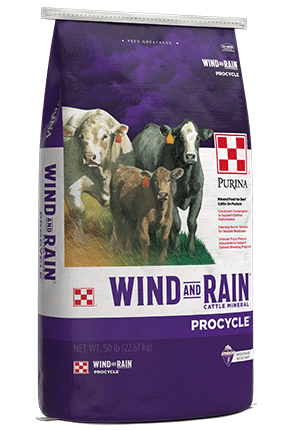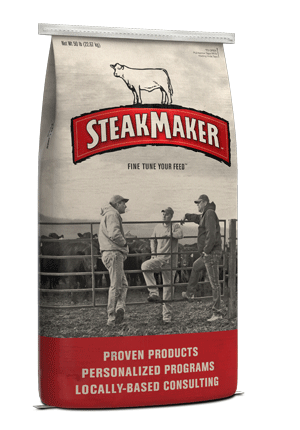
Phases for Successful Replacement Heifer Development
Management : Cow & Calf
Management : Replacement

When’s the most important time to focus on nutrition during development of replacement heifers?
There isn’t just one time frame. Focus on nutrition throughout a heifer’s first two years of life, with special emphasis during three critical phases: the fetal to pre-weaning phase, the weaning to breeding phase and the breed-back phase.
That means it’s imperative to keep cows at a good body condition score year-round, through the nine months of gestation and beyond. Once the calf is born and at the cow’s side, cow nutrition continues to be important because she’s providing critical nutrients to the calf.
If a creep feed is offered to supplement calves, try to avoid getting calves too fat, which can cause potential lower milk production later on, as cows. Keep feed intake at one percent of body weight or less. Feeds with intake modifying properties can help address over-conditioning by encouraging calves to eat smaller, more frequent meals spread throughout the day.
Starter ration selection will likely depend on resources and preference. Use a complete or semi-complete starter feed in a hand-fed scenario and complete feed with intake modifying properties for a self-fed situation.
After two or three weeks on a starter ration, we recommend developing heifers in the same environment that they’re going to work in as productive cows. If you have some pasture and forage available to develop heifers, that’s the way to go.
A gain of 1.25-1.75 pounds per day is suggested during this phase to avoid over-conditioning. High-quality, cool-season forages may provide the nutrition needed to achieve such gains. On medium- to low-quality forage, more supplementation may be needed to maintain appropriate gains leading up to breeding.
Once heifers are bred, they should be big enough to sustain themselves more efficiently in a forage-based scenario. If ample forage is available, provide a baseline protein supplement, which should allow heifers to cruise into the third, and final, critical phase.
The breed-back phase can be challenging because heifers are still growing and have high nutritional needs. Increase supplementation, supplement at least 45 days before breeding season starts and continue for at least 45 days into the season. This strategy keeps first-calf heifers on an upward plane of nutrition going into the second round of breeding.
Forage quality will dictate how much additional supplementation is needed. If heifers have quality forage available, then an average of five pounds per head per day supplement is a realistic target. If grazed forage or hay quality is low, first-calf heifers may require an average of 10 pounds per head per day supplement.
A common mistake we see is that nutrition of first calf heifers is not pushed hard enough leading up to breed-back. You don’t want to play catch up and miss the window that may impact the next generation.
Once that female is bred-back for a second time, she should be well on her way to being a productive cow.
Does your nutrition program stack up? Find out with a Proof Pays feeding trial.
There isn’t just one time frame. Focus on nutrition throughout a heifer’s first two years of life, with special emphasis during three critical phases: the fetal to pre-weaning phase, the weaning to breeding phase and the breed-back phase.
Three critical phases of replacement heifer development:
1. Fetal to pre-weaning phase
Caring for replacement heifers should begin before heifer calves are even born. Research shows if you do not take care of the cow while she’s pregnant, the resulting heifer calves could suffer the consequences. Fetal programming can impact the heifer’s overall health at birth and during her entire life span.That means it’s imperative to keep cows at a good body condition score year-round, through the nine months of gestation and beyond. Once the calf is born and at the cow’s side, cow nutrition continues to be important because she’s providing critical nutrients to the calf.
If a creep feed is offered to supplement calves, try to avoid getting calves too fat, which can cause potential lower milk production later on, as cows. Keep feed intake at one percent of body weight or less. Feeds with intake modifying properties can help address over-conditioning by encouraging calves to eat smaller, more frequent meals spread throughout the day.
2. Weaning to breeding phase
The second most critical time in a heifer calf’s life is when she’s weaned. If we provide quality nutrition throughout the cow’s gestation and keep the cow/calf pair in good condition prior to weaning, we need to make sure we’ve got a top-notch weaning program, or our efforts could be wasted.Starter ration selection will likely depend on resources and preference. Use a complete or semi-complete starter feed in a hand-fed scenario and complete feed with intake modifying properties for a self-fed situation.
After two or three weeks on a starter ration, we recommend developing heifers in the same environment that they’re going to work in as productive cows. If you have some pasture and forage available to develop heifers, that’s the way to go.
A gain of 1.25-1.75 pounds per day is suggested during this phase to avoid over-conditioning. High-quality, cool-season forages may provide the nutrition needed to achieve such gains. On medium- to low-quality forage, more supplementation may be needed to maintain appropriate gains leading up to breeding.
Once heifers are bred, they should be big enough to sustain themselves more efficiently in a forage-based scenario. If ample forage is available, provide a baseline protein supplement, which should allow heifers to cruise into the third, and final, critical phase.
3. Breed-back phase
If we don’t take good care of heifers during the breed-back phase, all of the investment that we have in them up to this point is gone because we’ll have to cull a heifer that we can’t get bred back.The breed-back phase can be challenging because heifers are still growing and have high nutritional needs. Increase supplementation, supplement at least 45 days before breeding season starts and continue for at least 45 days into the season. This strategy keeps first-calf heifers on an upward plane of nutrition going into the second round of breeding.
Forage quality will dictate how much additional supplementation is needed. If heifers have quality forage available, then an average of five pounds per head per day supplement is a realistic target. If grazed forage or hay quality is low, first-calf heifers may require an average of 10 pounds per head per day supplement.
A common mistake we see is that nutrition of first calf heifers is not pushed hard enough leading up to breed-back. You don’t want to play catch up and miss the window that may impact the next generation.
Once that female is bred-back for a second time, she should be well on her way to being a productive cow.
Does your nutrition program stack up? Find out with a Proof Pays feeding trial.


.png?width=300&height=430&ext=.png)

